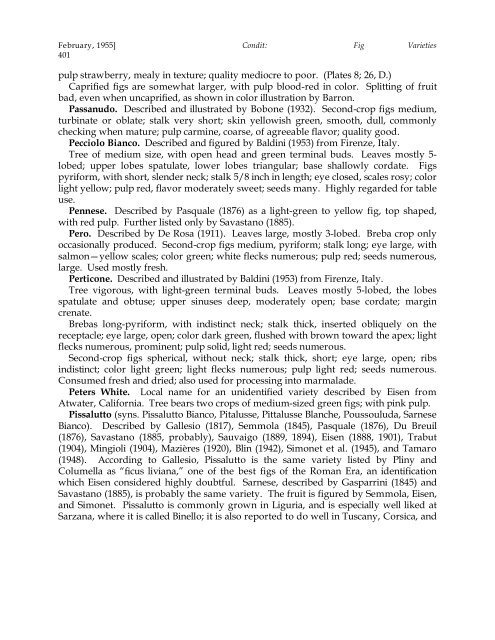Fig Varieties: A Monograph - uri=ucce.ucdavis
Fig Varieties: A Monograph - uri=ucce.ucdavis
Fig Varieties: A Monograph - uri=ucce.ucdavis
Create successful ePaper yourself
Turn your PDF publications into a flip-book with our unique Google optimized e-Paper software.
February, 1955] Condit: <strong>Fig</strong> <strong>Varieties</strong><br />
401<br />
pulp strawberry, mealy in texture; quality mediocre to poor. (Plates 8; 26, D.)<br />
Caprified figs are somewhat larger, with pulp blood-red in color. Splitting of fruit<br />
bad, even when uncaprified, as shown in color illustration by Barron.<br />
Passanudo. Described and illustrated by Bobone (1932). Second-crop figs medium,<br />
turbinate or oblate; stalk very short; skin yellowish green, smooth, dull, commonly<br />
checking when mature; pulp carmine, coarse, of agreeable flavor; quality good.<br />
Pecciolo Bianco. Described and figured by Baldini (1953) from Firenze, Italy.<br />
Tree of medium size, with open head and green terminal buds. Leaves mostly 5-<br />
lobed; upper lobes spatulate, lower lobes triangular; base shallowly cordate. <strong>Fig</strong>s<br />
pyriform, with short, slender neck; stalk 5/8 inch in length; eye closed, scales rosy; color<br />
light yellow; pulp red, flavor moderately sweet; seeds many. Highly regarded for table<br />
use.<br />
Pennese. Described by Pasquale (1876) as a light-green to yellow fig, top shaped,<br />
with red pulp. Further listed only by Savastano (1885).<br />
Pero. Described by De Rosa (1911). Leaves large, mostly 3-lobed. Breba crop only<br />
occasionally produced. Second-crop figs medium, pyriform; stalk long; eye large, with<br />
salmon—yellow scales; color green; white flecks numerous; pulp red; seeds numerous,<br />
large. Used mostly fresh.<br />
Perticone. Described and illustrated by Baldini (1953) from Firenze, Italy.<br />
Tree vigorous, with light-green terminal buds. Leaves mostly 5-lobed, the lobes<br />
spatulate and obtuse; upper sinuses deep, moderately open; base cordate; margin<br />
crenate.<br />
Brebas long-pyriform, with indistinct neck; stalk thick, inserted obliquely on the<br />
receptacle; eye large, open; color dark green, flushed with brown toward the apex; light<br />
flecks numerous, prominent; pulp solid, light red; seeds numerous.<br />
Second-crop figs spherical, without neck; stalk thick, short; eye large, open; ribs<br />
indistinct; color light green; light flecks numerous; pulp light red; seeds numerous.<br />
Consumed fresh and dried; also used for processing into marmalade.<br />
Peters White. Local name for an unidentified variety described by Eisen from<br />
Atwater, California. Tree bears two crops of medium-sized green figs; with pink pulp.<br />
Pissalutto (syns. Pissalutto Bianco, Pitalusse, Pittalusse Blanche, Poussouluda, Sarnese<br />
Bianco). Described by Gallesio (1817), Semmola (1845), Pasquale (1876), Du Breuil<br />
(1876), Savastano (1885, probably), Sauvaigo (1889, 1894), Eisen (1888, 1901), Trabut<br />
(1904), Mingioli (1904), Mazières (1920), Blin (1942), Simonet et al. (1945), and Tamaro<br />
(1948). According to Gallesio, Pissalutto is the same variety listed by Pliny and<br />
Columella as “ficus liviana,” one of the best figs of the Roman Era, an identification<br />
which Eisen considered highly doubtful. Sarnese, described by Gasparrini (1845) and<br />
Savastano (1885), is probably the same variety. The fruit is figured by Semmola, Eisen,<br />
and Simonet. Pissalutto is commonly grown in Liguria, and is especially well liked at<br />
Sarzana, where it is called Binello; it is also reported to do well in Tuscany, Corsica, and
















![Fig Trees in North Carolina [Archive] - IDigMyGarden ... - Figs 4 Fun](https://img.yumpu.com/26905320/1/190x245/fig-trees-in-north-carolina-archive-idigmygarden-figs-4-fun.jpg?quality=85)